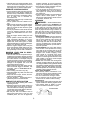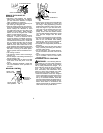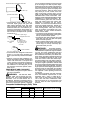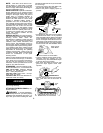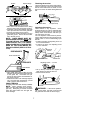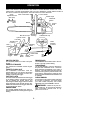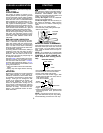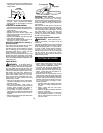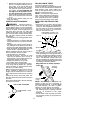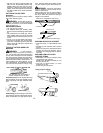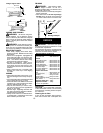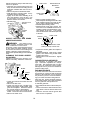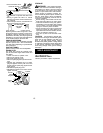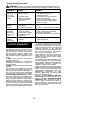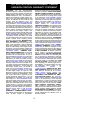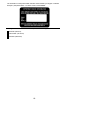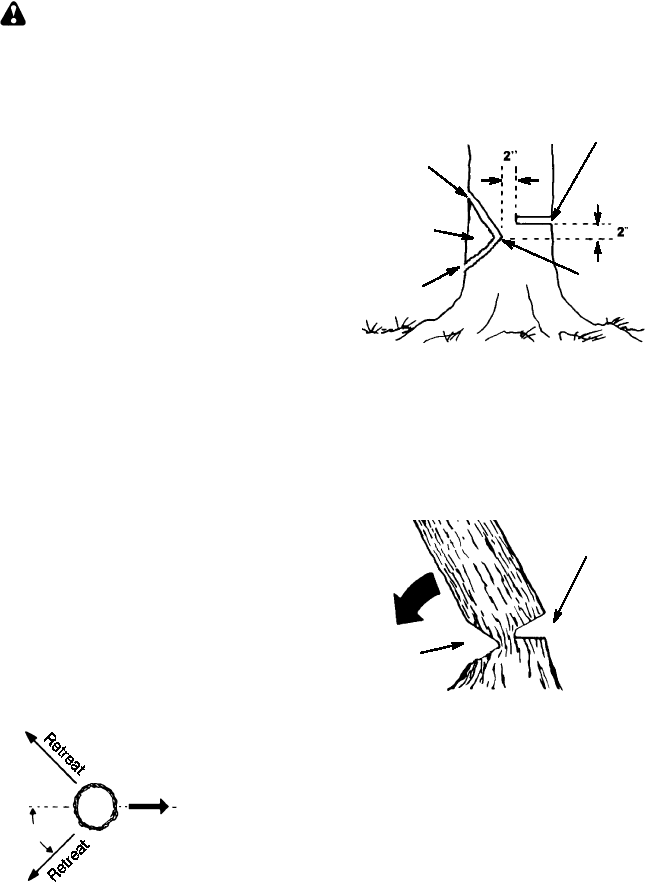
11
S
Release the throttle trigger as soon as
the cut is completed, allowing the en-
gine to idle. If you run the saw at full
throttle without acutting load, unneces-
sary wear can occur to the chain, bar,
and engine. It is recommended that
the engine not be operated for lon-
ger than 30 seconds at full throttle.
S
Toavoid losing control when cut iscom-
plete, donot putpressure onsaw atend
of cut.
S
Stop the engine before setting the saw
down after cutting.
TREE FELLING TECHNIQUES
WARNING:
Check for broken or
dead branches which can fall while cutting
causing serious injury. Do not cut nearbuild-
ings or electrical wires if you do not know the
direction of tree fall, norcut at night since you
will not be ale to see well, nor during bad
weather such asrain, snow ,or strong winds,
etc. If the tree makes contact with any utility
line, the utility company should be notified
immediately.
S
Carefully plan your sawing operation inad-
vance.
S
Clear thework area. You need a clear area
all around the tree so you can have secure
footing.
S
The chain saw operator should keep on
the uphill side of the terrain as the tree is
likely toroll orslide downhill after it is felled.
S
Study the nat ur al conditions that can c ause
the tree to fall in a particular direction.
Natural conditions that can cause a tree to
fall in a particular direction include:
S
The wind direction and speed.
S
The lean of the tree. The lean of a tree
might not be apparent due to uneven or
sloping terrain. Use aplumb orlevel to de-
termine the direction of tree lean.
S
Weight and branches on one side.
S
Surrounding trees and obstacles.
Look for decay and rot. If the trunk is rotted,
it can snap and fall toward the operator.
Check for broken or dead branches which
can fall on you while cutting.
Make sure there is enough room for the tree
to fall. Maintain a distance of
2-1/2
tree
lengths from the nearest person or other ob-
jects. Engine noise can d rown out a warning
call.
Remove dirt, stones, loose bark, nails, sta-
ples, and wire from the tree wherecuts are to
be made.
Plan a clear retreat path to the rear and diag-
onal to the line of fall.
Direction of Fall
45
_
Plan a clear retreat path
FELLING LARGE TREES
(6 inches i n diameter or larger)
The notch method is used to fell large trees.
A notch is cut on the side of the tree in thede-
sired direction of fall. After a felling cut is
made on the opposite side of tree, the tree
will tend to fall into the notch.
NOTE:
If the tree has large buttress
roots, remove them bef ore making the
notch. If using saw to remove buttress
roots, keep saw chain from contacting
ground t o prevent dulling of the chain.
NOTCH CUT AND FELLING THE
TREE
S
Make notch cut by cutting the top of the
notch first. Cut through
1/3
of the diameter
of thetree. Nextcomplete the notch by cut-
ting the bottom of the notch. See illustra-
tion. Once the notch is cut remove the
notch of wood from the tree.
Notch
First cut
Second cut
Final (felling) cut here. 2 in-
ches above center of notch.
Hinge
S
After removing the wood from the notch,
make the f elling cut on the opposite side of
the notch.This isdone bymakinga cut about
two inches higher than the center of the
notch. This will leave enough uncut w ood
betw e e n the fellin g c ut and th e no tc h to for m
a hinge. This hinge will help prevent the tree
from falling in the w rong d irectio n .
Opening
of felling
cut
Closing of
notch
Hinge holds tree on stump and helps
control fall
NOTE:
Before felling cut is complete, use
wedges to open the cut if necessary to
control the direction of fall. To avoid kickback
and chain damage, use wood or plastic
wedges, but never steel or iron wedges.
S
Be alert to signs that the tree is ready to
fall: cracking sounds, widening of the fell-
ing cut, or movement in the upper
branches.
S
As tree starts to fall, stop saw, put it down,
and get away quickly on your planned re-
treat path.



